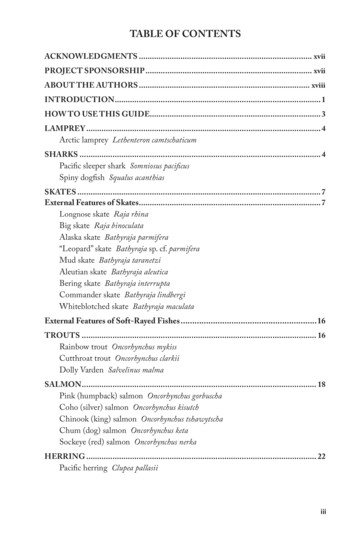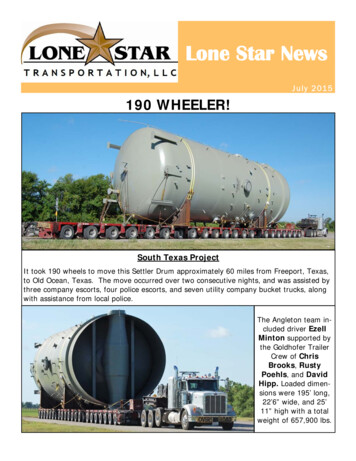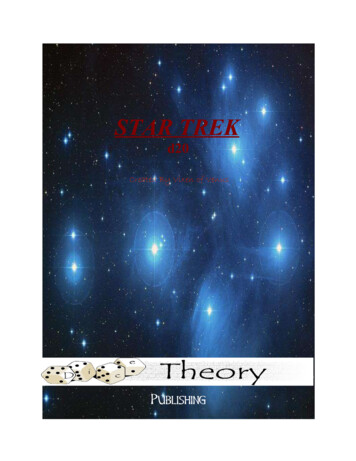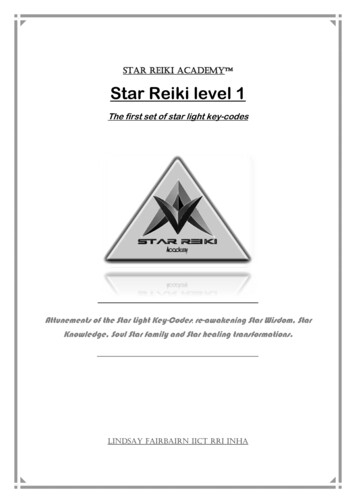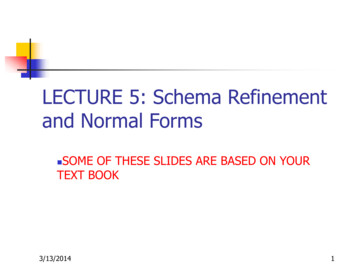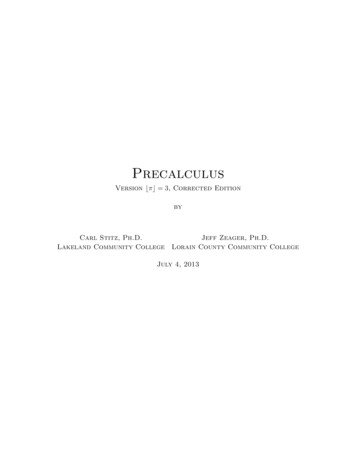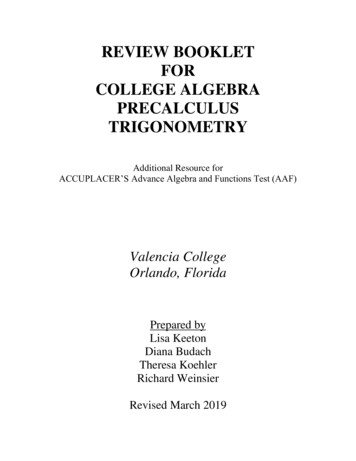
Transcription
PRECALCULUSMath 2412TurnellUpdated Dec. 2019-page 10 #20 answer[Type thedocumentsubtitle]
VectorsDefinition: A vector has and .Definition: A scalar has only .VectorsScalarsA vector is represented geometrically as a directed line segment where themagnitude of the vector is taken to be the length of the line segment and thedirection is made clear with the use of an arrow at one endpoint of the segment.Q (4,6)P (1,2)The point P is called the point or and the point Q isG Gcalled the point or of the vector v . vJJJGPQComponent Form: One way to write a vector is in component form:Gv a,b ! , where a is the x-component andb is the y-component.Gvx 2 x1 , y2 y1(Terminal – Initial)JJJGJJJGWrite PQ in component form and graph PQ . Some books call this avector. It is convenient because the initial point is (0,0)Page 1
Adding Vectors. Find the following:G G1. u vG G2. w vG G3. u wG G G4. u v wGG5. v 2wGuGvGw Find the magnitude of a vector : GIf v a,b ! , the magnitude of a vector is the or ofa directed line segment. The magnitude is defined to be:vIf P1( 3,2) and P2a 2 b2JJJJG(6,5) , find the magnitude of P1P2Find a unit vector in the direction of a given vector: A unit vector is a vector that has a length or magnitude of .For any nonzero vector v , the vector uuis a unit vector that has the same direction as v .uExample:Find a unit vector in the direction of v 3, 4 !Page 2
Principal Unit Vectors The vector iˆ is defined by iˆ1,0 and The vector ĵ is defined by jˆ0,1We can think of the vector iˆ as representing the positive x-direction,while ĵ represents the positive y-direction.Example:Find a unit vector in the direction of v 2, 1 ! . Write your answer in theGform of v aiˆ bjˆ Find the components of a vector. Review of trigonometry:GFind the vector with the given information. Write your answer in the form of vGiven v8 and the angle,T , that v makes with the positive x-axis is 45DGiven v10 and the angle, T , that v makes with the positive x-axis is 240DPage 3aiˆ bjˆ
Direction angle of a vector: The direction angle of a vector is the angle that the vector makes with thepositive x-axis:Find the direction angle of the given vectors.v 3,4 !v 5,5 !v 2, 7 !v 3, 8 !Application: A car weighing 3000 lbs. is parked on a driveway that is inclined 15 to thehorizontal. Find the magnitude of the force required to prevent the car from rolling down thedriveway. Find the magnitude of the force exerted by the car on the driveway. (How does thisrelate to the "Normal" force that you learned in physics class?)Page 4
Resultant VectorsDefinition: The resultant is the vector sum of two or more vectors. It is the result of addingtwo or more vectors together.Resultants: 1. Two forces of magnitude 30 newtons and 70 newtons act on an object at anglesDDof 45 and120 with the positive x-axis. Find the direction and magnitude of the resultantforce.2. A jet maintains a constant airspeed of 500 mi/hr headed due west. The jet stream is 100 mi/hrin the southeasterly direction.Find the resultant vector representing the path of the plane relative to the ground. What is theground speed of the plane? What is its direction?Page 5
D3. An airplane has an airspeed of 600 km/hr bearing 30 east of south. The wind velocity is 40Dkm/hr in the direction of 45 west of north. Find the resultant vector representing the path ofthe plane relative to the ground. What is the ground speed of the plane? What is its direction?Definition: When all the forces that act upon an object are balanced, then theobject is said to be in a state of equilibrium. The forces are considered to bebalanced if the rightward forces are balanced by the leftward forces and theupward forces are balanced by the downward forces. In other words, theirresultant equals 0. This is a very important concept in physics (engineering).4. Find the direction and magnitude of the force that will keep object P in static equilibrium.F1 150 lbs. at 110DF275 lbs. at 180DF3240 lbs. at 35DPPage 6
5. A weight of 800 pounds is suspended from two cables. What are the tensions in the 2 cables?35 50 800 lbs.Page 7
VectorsAdding Vectors. Graph the following vectors.GG1. u 2vGG2. w tWrite theG G following in component form.3. 3u wG G G4. u t wGG5. 3t 2wGuGtGvGwG6. The vector v has initial point P (9,7) and terminal point Q (6,8) .Ga ) Write v in component form, that is, find its position vector.Gb) Find the magnitude of v .G7. The vector v has initial point P (3,6) and terminal point Q ( 3,4) .Ga ) Write v in component form, that is, find its position vector.Gb) Find the magnitude of v .GFind a unit vector in the direction of v .GWrite your answer in the form of v8. v 6, 8 ! .aiˆ bjˆ9. v 2, 1 ! .Find the vector with the given information.G10. Given vaiˆ bjˆ (exact values)9 and the angle, T , that v makes with the positive x-axis is 30D11. Given v12 and the angle, T , that v makes with the positive x-axis is 300DWrite your answer in the form of vPage 8
12-14 Find the direction angle of the given vector. Round approximationsto two decimal places.GGG12. v 5,5 !13. v 2, 5 !14. v 2, 4 !15. A car weighing 2500 lbs. is parked on a driveway that is inclined 10 to thehorizontal. Find the magnitude of the force required to prevent the car fromrolling down the driveway. Find the magnitude of the force exerted by the caron the driveway.GGG16. Three forces act on an object: F1 2, 5 , F2 8, 3 , F30, 7 . Find the directionand magnitude of the resultant force.Find the magnitude and direction of the resultant vector. All angles aremeasured from the positive x-axis.o17.F18.Foo37 and D 175D , G25 and Do78D , Go15 and E31 and E230D , Jo160D , J29 and M16 and M310D .240D .19. Two forces of magnitude 20 newtons and 50 newtons act on an object at anglesDDof 35 and160 with the positive x-axis. Find the direction and magnitude ofthe resultant force.20. A jet maintains a constant airspeed of 750 mi/hr headed due west. The jetstream is 80 mi/hr in the southeasterly direction. Find the resultant vectorrepresenting the path of the plane relative to the ground. What is the groundspeed of the plane? What is its direction?D21. An airplane has an airspeed of 650 km/hr bearing 15 north of west. The windDvelocity is19 km/hr in the direction of 30 east of south. Find the resultantvector representing the path of the plane relative to the ground. What is theground speed of the plane? What is its direction?22. A weight of 600 pounds is suspended from two cables. What are the tensions in the 2 cables?28 70 600 lbs.Page 9
Answers-Vectors1.2. 0, 8 0, 2 18, 10 a) 3,1 b) 107. a) 6, 2 b) 2 103 48. i j5 5219.i j559 3 9i j10.2211. 6i 6 3 j12. 135 13. 291.8 14. 243.4 15. 2462 lbs. & 434 lbs.16. 5.7 , 10117. R 27.86i 30.48 jR 41.3 , 227.6 18. R 31.93i 21.2 jR 38.33 , 146.4 19. R 30.6i 28.57 jR 41.87 , 137 20. R 693.4i 56.57 jR 695.7 (speed), 184.7 3.4.5.6.or 4.7 south of west21. R 618.4i 151.8 jR 636.7 (speed), 166.2 or 13.8 north of west22. T1 535 lbs. T2 207 lbs.Page 10
Dot ProductDefinition: If vdefined asa1i b1 j and wa2i b2 j are two vectors, the dot product isv wThe dot product is a , NOT a2i 3 j and wExample 1: Given two vectors: vProperty of Dot Product is v vv4i 7 j . Find v w2The dot product can be used to find the angle between 2 vectors.cos Tu v, where 0 d T d 180Dv uExample2 : Find the angle between thegiven vectors: v 2i 3 j and w 4i 7 j.Page 11
How to determine if 2 vectors are parallel:The angle between the two vectors are 0D or 180DExample3 : Determine if the two vectors are parallel: v3i j and w6i 2 j.How to determine if 2 vectors are orthogonal:Two vectors are orthogonal if the angle between the two vectors is 90DSince the cos(90D ) and cos Tu v, then we can conclude:v uExample 4 : Determine if the two vectors are orthogonal:v 2i j and w 3i 6 j.Page 12
Decompose a Vector into Two Orthogonal Vectors Decompose v into 2 vectors v1 and v 2where v1 is parallel to wand v 2 is orthogonal to w§ v w · w and v2 v v1v1 w2 ¹Example 5:Find the vector projection of v i 3 j onto w i j. Decompose v into 2 vectorsv1 and v 2 where v1 is parallel to w and v 2 is orthogonal to w.Example 6:Find the vector projection of v 2i j onto w i 2 j . Decompose v into 2 vectorsv1 and v 2 where v1 is parallel to w and v 2 is orthogonal to w.Page 13
The dot product can be used to find the angle between 2 vectors.cos Tu v, where 0 d T d 180Dv uLaw of cosines: c 2Page 14a 2 b2 2ab cos T
Vectors in SpaceFind the distance between two points in 3Ǧspace: Find the distance between P1Distance x 2 x12 y2 y1( 2,2,3) and P22 z2 z1(4,3, 3) .2Find a position vector. Suppose that v is a vector with initial point P1P2( x2 , y2 , z2 ) . If v( x1 , y1 , z1 ) and terminal pointJJJJGP1P2 , then v is equal to the vector.vx2 x1 i y2 y1 j z2 z1 k(TerminalJJJJG– Initial)Find the position vector of the vector v P1P2 if P1 ( 2,2,3) and P2(4,3, 3) . Find the magnitude of a vector in space: If , v a,b, c ! then the magnitude of a vector is the of adirected line segment. The magnitude is defined to be:vFind the magnitude of va 2 b2 c2JJJJGP1P2 (see previous example)Page 15
Find the Dot Product of a vector in space: Definition: If v a1i b1 j c1k and u a2i b2 j c2k are two vectors, the dotproduct is defined asv uThe dot product is a , NOT aExample: Given two vectors: v2i 2 j k and ui 3 j 4k . Find v uFind the angle between 2 vectors in space: Recall that the angle between 2 vectors can be found by usingu vcos T, where 0 d T d 180Dv uFind the angle between v and u (see given vectors in previous example)Find a unit vector in the direction of a given vector: Recall a unit vector is a vector that has a length or magnitude of .For any nonzero vector v , the vector uuis a unit vector thatuhas the same direction as v .Example:Find a unit vector in the direction of vPage 169i 3 j k
Cross ProductThe cross product is a that is orthogonal to theplane of v and uInvestigate the "Right-Hand" RuleDefinition: If v a1i b1 j c1k and uproduct is defined asv ua2i b2 j c2k are two vectors, the cross(b1c2 c1b2 )i (c1a2 a1c2 ) j ( a1b2 b1c2 )kInstead of memorizing such an intricate formula, we can use the following methodsto help us find the cross product.Example 1: Given two vectors: v i 3 j 2k and wOption 1: Using determinants :A 2 2 determinant:ij2 13 4k 1 3 23 2 1Page 173i 2 j k . Find v w
Option 2: Using diagonals:ijk 1 3 23 2 1Example 2: Given 3 vectors: uFind u v w2i 3 j k , vPage 18 3i 3 j 2k and wi j 3k .
Dot and Cross ProductG GFind u vG1. uG3. uGG G G G G2. u 5i 6 j , v 4i 7 jG G GG G G GG4. u i 4 j 2k , v 3i j 6kG G G G G 4i 2 j , v i 5 jG GG GG GG 3i 2 j 5k , v 2i j 6kFind the angle between the given vectors. Roundto nearestdegree.GGGG6. u 8,3 ! , v 2, 6 !5. u 2, 7 ! , v 5, 9 !GGGG7. u 1, 4, 2 ! , v 2,5, 3 !8. u 3, 5, 1 ! , v 4, 6, 10 !Determine if the given vectors are parallel, orthogonal,orneither.GGGG9. u 3, 4 ! , v 6, 8 !10. u 8, 4 ! , v 2, 4 !GGGG11. u 2, 7 ! , v 3, 9 !12. u 5, 6 ! , v 12, 10 !Decompose v into two vectors v1 and v2 , where v1 is parallel to wand v2 is orthogonal to w . Leave answers in fractional form. NODECIMALSG G G JGG GGG G JGG G13. v 8i 3 j , w 2i 6 j14. v i 3 j , w 4i jGGThe vector v has initial point P and terminal point Q. a) Write v in theGG GGform ai b j ck ; that is, find its position vector. b) Find the magnitude of v15. P ( 2,5,1); Q ( 7,1, 4)16. P (1, 2, 3); Q (5, 7, 4)GFind a unit vector in the direction of v .GG17. v 1, 4, 3 ! .18. v 2, 6,1 ! .Evaluate the given determinants. 5 619.420.28 9 46G G JGUse the given vectors v , u , w to find each expression.GGJGu 2, 3,1 ! , v 3,3,2 ! , w 1,1,3 !G JG22. u u wG G JJG24. v u u wG JG21. v u wG JG G23. u w u vPage 19
Answers—Dot and Cross Product1.2.3.4.5.6.7.8.9.287i j17 17 11 44v2i j171715. a) PQ 5i 4 j 5k6 62261914. v1T 45DT 87.8DT 148.2DT 96.4D66b) PQ16. a) PQ 4i 5 j kparallel10. orthogonal17.11. neither18.12. orthogonal13i j13. v110 10 81 27v2i j101019.20.21.22.23.24.Page 20b) PQ4214i j 2626 26i j 4141 34127,11, 6 ! 10, 5,5 !25253k261k41
Polar CoordinatesHow to plot polar coordinates: (r,T )Example 1: Plot the point (5,120D ) . Give three equivalent expressions for the point.Example 2: Plot the point ( 4,210D ) . Give three equivalent expressions for thepoint.Page 21
S·§Example 3: Plot the point 5, . Give three equivalent expressions for the point.3¹ 5S§Example 4: Plot the point 6, 4 point.· . Give three equivalent expressions for the¹Page 22
Convert Polar to Rectangular and Rectangular to Polar Rectangular ( x , y )Polar (r ,T )Convert the point from rectangular coordinates into polar coordinates wherer t 0 and 0 d T 2SExample 5: 2, 2 3Example 6: 3,2Convert the point from polar coordinates into rectangular coordinates.5S ·§Ex 8: 4,Ex 9: 8.1,5.2Ex7: 5,300D6 ¹ Page 23
Page 24
Polar Coordinates1. Given point B on the graph, give 4 different polar coordinates for point B withthe following restrictions: RADIANS(a) r ! 0, 0 d T 2S(b) r 0, 0 d T 2S(c) r ! 0, 2S T d 0(d) r 0, 2S T d 0xB2. Given point B on the graph, give 4 different polar coordinates for point B withthe following restrictions: RADIANS(a) r ! 0, 0 d T 2S(b) r 0, 0 d T 2S(c) r ! 0, 2S T d 0(d) r 0, 2S T d 0BxConvert the point from rectangular coordinatesinto polar coordinates where r t 0 and 0 d T 2S3. (4, 2)4. ( 4, 6)5. (3, 5)6. ( 4, 7)Convert the point from polar coordinates into rectangular coordinates. Use exactvalues, if possible.S·S·§§ 7S ·§7. 7,8. 6, 9. 12, 3¹4¹ 6 ¹ § S·10. 3, 2¹11. (3, 2)12. (7,1)Page 25
Answers—Polar Coordinates§ 5 ·1. a) 4, S 3 ¹2 ·§b) 4, S 3 ¹ § 1 ·c) 4, S 3 ¹ 4 ·§d) 4, S 3 ¹ § 7 ·2. a) 5, S 6 ¹1 ·§b) 5, S 6 ¹ § 5 ·c) 5, S 6 ¹ 11 ·§S d) 5,6 ¹ 3.4.2 13,2.165.34,5.256.65,4.19§ 7 3 7 ·, 7. 22 ¹ 8. 3 2, 3 29.6, 6 310. (0,3)11. ( 1.25, 2.73)12. (3.78,5.89)2 5,0.46Page 26
Polar GraphsLines: TTaS3Circles: rar cosTar sin Tar cosT4r sin T 3rr2a cosTrr2a sin Tr6sin TThe of the circle is 2ar3r 2cosT Use Graphing Calculator to investigate symmetry: For TI-83: MODE is Pol, Deg. or Rad,WINDOW must correspond with Deg. or Rad.Graph the following with calculator: r 3 3cosT , rr 5 3sin T Page 273 3cosT , r3 4sin T ,
Cardioids (hearts): rr 3 3cosTra r a cosTra r a sin T2 2sin TLimaçons with a loop: rr 2 4cosTljr0 60 90 180 270 300 a r b cosTra r b sin T where a br 1 4sin Tljr0 90 180 270 360 The graph passes through the pole when lj and Page 28
Limaçons without a loop : rr 6 4cosTljr0 90 180 270 rlj0 90 180 270 a r b sin T where a ! br5 4sin TrLemniscate (a figure 8) : r 2r2a r b cosTa 2 cos(2T )r225cos(2T )a 2 sin(2T )r 2 16sin(2T )r a sin(nT )Rose Curves: r a cos(nT )The length (from pole to tip) of each "petal" isNumber of petals: If n is even, then curve has petals.If n is odd, then curve has petals.Page 29
Where to place each petal:1. For r a cos(nT ) , the first petal will always be when lj . Thespacing (how far apart) of each petal is found by dividing 360 by number of.r4cos(5T )r5cos(4T )2. For r a sin(nT ) , the first petal is found by dividing by . The spacing(how far apart) of each petal is found by dividing 360 by number of .r4sin(5T )rPage 305sin(4T )
Polar GraphsGraph and complete the table:1. Graph r 2 2 cos T3. Graph r 25. Graph r2. Graph: r25sin(2T )6 4 sin T4. Graph: r 1 3cos T3 3sin T6. Graph: rPage 315 3cos T
7. Graph r4cos(3T )9. Graph r 2 16cos(2T )8. Graph: r2 5sin T10. Graph: r5sin(2T )11. Refer to problem #4: Show work!The graph passes through the pole when lj and12. Refer to problem #8: Show work!The graph passes through the pole when lj and14.The following is a rose curve: r5 cos(10T )How many petals are there?How far apart is each petal?Where is the first petal located? (at what angle?)15.The following is a rose curve: r5sin(12T )How many petals are there?How far apart is each petal?Where is the first petal located? (at what angle?)Page 32
Answers—Polar GraphsGraph and complete the table:1. Graph r 2 2cos T3. Graph r 25. Graph r2. Graph: r25sin(2T )6 4sin T4. Graph: r 1 3cos T3 3sin T6. Graph: rPage 335 3cos T
7. Graph r4cos(3T )9. Graph r 2 16cos(2T )8. Graph: r2 5sin T10. Graph: r5sin(2T )11. Refer to problem #4: Show work!The graph passes through the pole when lj and12. Refer to problem #8: Show work!The graph passes through the pole when lj and14.The following is a rose curve: r5cos(10T )How many petals are there?How far apart is each petal?Where is the first petal located? (at what angle?)15.The following is a rose curve: r5sin(12T )How many petals are there?How far apart is each petal?Where is the first petal located? (at what angle?)Page 34
Complex NumbersDefinition: A complex number z a bi can be interpreted geometrically as thepoint ( a,b) in the xy-plane, where the x-axis is the real axis and the y-axis is theimaginary axis.Definition: The magnitude or modulus of z is the distance from the point ( a ,b) tothe origin.za 2 b2Example 1: Plot the point z3 2i . Find the magnitude (Modulus) of z. Change from Rectangle Form to Polar Form: Rectangular Form: z a biPolar Form: zr(cos T i sin T ) or zr(c i s T ) , r t 0 and 0 d T 2S or 0 d T 360DExample 2: Write in polar form: z3 2i . Express angle in degrees.Example 3: Write in polar form: z 3 5i . Express angle in degrees.Page 35
Example 4: Write in rectangular form: zSS ·§3 cos i sin .1010 ¹ Multiplication and Division of Complex Numbers: Given 2 complex numbers, zzwExample 5: Given zr1 (cosT1 i sin T1 ) and w(r1r2 )(c i s(T1 T2 )) and2(c i s(80D )) and wzwr2 (cos T2 i sin T2 ) , then§ r1 · (c i s(T1 T2 )) r2 ¹6(c i s(200D )) , Find zw andWrite answer in rectangular form. Page 36z.w
DeMoivre's Theorem: This theorem allows us to raise complex numbers to powers.If z r(cos T i sin T ) is a complex number, then z n r n (cos(nT i sin(nT ) , wheren is a positive integer.Example 6: If z5S ·§2 cis, find z 4 . Write answer with exact values in 16 ¹ rectangular form.Example 7: Find63 i . Write answer in rectangular form.Page 37
We can also use DeMoivre's Theorem to find roots of complex numbers. Remember,if you are asked to find the cube root of a number, there are 3 complex roots. Thefourth root yields 4 complex roots, and so on.When you look in a text book, this is the formula that you will see:§ § T 2S · ·zk n r cis k , where k 0,1,2,., n 1 n n ¹¹Looks scary, but don't panic.Example 8: Find the 4 fourth roots of3 i . Leave answers in polar form.Example 9: Find the 5 fifth roots of i . Leave answers in polar form.Page 38
Complex NumbersRound to 2 decimal places or use exact values, if possible:1. Plot the complex number in the complex plane and find the magnitude(Modulus) of z. z 3 8i2. Plot the complex number in the complex plane and find the magnitude(Modulus) of z. z 4 5i3. Write in polar form: z 3 i . Express the angle in degrees ( 0D d T 360D )4. Write in polar form: z 5 2i . Express the angle in degrees ( 0D d T 360D )5. Write in rectangular form: z6. Write in rectangular form: z7. If z5S5S ·§3 cos. i sin66 ¹ 3S3S ·§6 cos i sin .55 ¹8(cos 30D i sin 30D ) and w 2(cos 45D i sin 45D ) , find zw andanswers in rectangular form.8. If z 12(cos80D i sin 80D ) and w 2(cos 20D i sin 20D ) , find zw andanswers in rectangular form.z. Leave yourwz. Leave yourw4ª §SS ·º9. Find: «3 cos i sin » . Write the expression in the rectangular form.66 ¹¼ 10ª §SS ·º10. Find: « 2 cos i sin » . Write the expression in the rectangular form.44 ¹¼ 11. Find:4 4i . Write the expression in the rectangular form.12. Find: 3 i . Write the expression in the rectangular form.6513. Find the complex fifth roots of 5 3i . Leave your answers in polar form withthe argument in degrees. 0D d T 360D14. Find the complex sixth roots of 2 . Leave your answers in polar form with theargument in degrees. 0D d T 360DPage 39
Answers—Complex Numbers1. z7310. 0 32i11. 0 32768i12. 16 3 16i2. z13.413. 2(cos150D i sin150D )4.5.6.7.8.9.534 (cos6.19D i sin 6.19D )534 (cos78.19D i sin 78.19D )534 (cos150.19D i sin150.19D )534 (cos 222.19D i sin 222.19D )534 (cos 294.19D i sin 294.19D )29(cos 201.80D i sin 201.80D ) 3 3 3 i22 1.85 5.71izw 4.14 15.45iz3.86 1.04iwzw 4.17 23.64iz3 3 3iw 81 81 3 i2262(cos0D i sin 0D )62(cos60D i sin 60D )62(cos120D i sin120D )62(cos180D i sin180D )62(cos 240D i sin 240D )62(cos300D i sin 300D )14.Page 40
Graphing Trig FunctionsReview of Cosine and Sine y sin( x)1. Period 2S 2. Range 1,1@yA sin( Bx C ) Dy cos( x)yA cos( Bx C ) D Amplitude Vertical Shift Phase Shift PeriodEx. 1: Graph the following over a one period interval.Page 41S·§y 3sin 2 x 12¹
Ex. 2: Graph the following over a one period interval.Review of Tangent and Cotangent y tan( x)yPeriod S Range f, f @yA tan( Bx C ) D "Amplitude"yyS·§1 2cos x 14¹ 2cot( x)A cot( Bx C ) D Vertical Shift PeriodPage 42
Ex. 3: Graph the following over a one period interval.y1S·§tan 2 x 223¹ Ex. 4: Graph the following over a one period interval.yS·§12cot S x 14¹ 2Review of Cosecant and Secant y csc( x)y sec( x)Page 43
Ex. 5: Graph the following over a one period interval.S·§y 3csc 2 x 14¹ Ex. 6: Graph the following over a one period interval.yPage 441 §1S· sec x 3 23¹
Deg.0 30 Rad.045 S60 S90 S120 2S135 3S150 5S180 210 S225 5S240 4S270 3S300 5S315 7S330 11SSSinlj016337S32212332461432346 12 2 32 2 12 3 2212222322CotljUnd.2 332222Und.1 32 3 130322313 2 3 21 2 2 2 3 2 3 1 2Page 450 1 2 3 2333Und.Und. 133 2 3Und. 312 2 333232 320 1 12 1 3Seclj02 33 323CscljUnd.212 220632 12Tanlj020121224Coslj3 3Und.331 233Und.02 3 122 333 33
Graphing Trig FunctionsGraph over a one period interval. Following class procedure, label thevertical and horizontal axes accordingly.SS1. y 2sin § x · 322. y cos § x · 248¹ 4S3. y tan § x · 34. y 1¹1sin 2 x 3S 121§Sx S ·6. ytan 2 4 4¹2§3·8. ycos x S 23 4¹1§1·10. ysec x S 24 2¹3¹S5. y 2 cot § x · 4¹7. y cot 3x S 13S9. y csc § x · 124 ¹ 13Page 46
Answers—Graphing Trig Functions1. y-S2S·§2sin x 32¹ S2-13S x2SS6S3S 2S 5S S 7S 4S 3S 5S 11S 2S 13S 7S 5S2 3 66 3 2 3 66 3 2-2-3-4-5-52yS·§tan x 33¹ y tan § x S · – 33¹ 7S12y – § 1· cos§ § 3· x S· – 28¹ 4¹ 4¹-94y 2 sin § x S · – 32¹ 5ʌ6-S6 -32-74-23. y1S·§3 cos x 248¹ 42. y S12 ʌ31sin 2 x 3S 124. yyyy 1 sin ( 2 x – 3 S ) – 12S3S2-12x7S42S9S4x5S2-1-2 6-3-32-4-25. yS·§2 cot x 4¹ 6. y1§Sx S · tan 2 4 4¹yyy 1 tan § S x S · 24¹ 464y 2 cot § x S · 4¹ 1/22-S4-2S4S2-33S x4-2-10-1/2-4Page 471x
7.ycot 3x S 18. y2§3·cos x S 23 4¹y5y cot ( 3 x – S ) 14321S3-15S12S27S122S x3-2-3-49. y13S§ csc x 24 · 1¹1§1·sec x S 24 2¹10. yyy43/211/29/47/423 S S 5 S 3 S 7 S 2 S 9 S 5 S 11 S x44 2 44 2 4S-2Page 482S3S4S5S6S7S x
Trig Equations—Part 1Solve the following in the given interval. Give exact answers, if possible. Round answers to 2decimal places when necessary.1[0,2S )2. 2cos x 3[0, S )1. sin x23. sec x 4(0,2S )4. csc x 3Page 49(0,2S )
5. 2sin 2 x 3sin x 1 07. 2cos 2 x6S9. 2 tan 2 x 6 0[0,4S )ª S Sº« 4 , 4 »¼[0,2S )Page 506. 2cos 2 x 5cos x 2 0[0,2S )8. 2sin x cos x 3 cos x 0[ S , S ]
Trig Equations—Part 2Pythagorean Identities:cos2 T sin 2 T 11 tan 2 T sec2 Tcot 2 T 1 csc2 TDouble Angle Identities:sin 2T 2cosT sinTcos2T cos2 T sin 2 Tcos2T 2cos2 T 1cos2T 1 2sin 2 T1. 3tan 2 T sec2 T 5 0 [0,2S )2. cos2 T cosT 1 0 [0,2S )3. 2sin 2 T cos2T4. 3cosT 3 2sin 2 T0[0,2S )Page 51[0,2S )
5. cos 2T 3 5cosT7. sin 2T 1[0,2S )6. 3cos 2 x sin x 2[0,2S )8. cos 2TPage 5232[0,2S )[0,2S )
9. 2sin 2 3 x sin 3 x 1 0[0,2S )10. tan 2 (3 x) 1[0,2S )11. 2cos x 1 sec x[0,2S )Page 53
Page 54
Trigonometric EquationsFind all solutions of the equation in the given interval. Give exact answers where possible.Otherwise, round answers to 2 decimal places.Problem#1.1 cos x 02.3 2sin x3.4.5.6.7.01 2cos x 12cos x 2cos 2 x 021.2cos x 2sin 2 x 0 0, 4S22. sin x sin 2 x 0 S , S @23. 2sin x 4sin 2 x 0ª S Sº« 3 , 3 » ¼24.sin 2 x cos x3 32S25.2sin x sin 2 x 026.cos 2 x sin 2 x27. cos x 2cos 2 x 028. S sin S x 029.2cos 2 x 030.1xcos0221x sin0421 SS cos x2 668.cos x9.sin x10.cos x11.2sin x cos x sin x 012.2sin x cos x cos x 013.2 sec x0§ S S· , 2 2¹14.2 csc 2 x00, S15.2 0, S @2S2S2 sec xSsec x tan x 017.2 csc 2 x cot x 0, 2S31.ª S Sº« 4 , 4 » ¼816.ª Sº«0, 2 » ¼[0, 2S )32.ª S Sº« 4 , 4 » ¼00, SPage 55tan x33.4 S sec2 S x34. 3csc0Interval[0, 2S )ª S Sº« 3 , 3 » ¼20. 0, 2S sin x 1 02secT tan T sec2 T2sin x 0, 2S0Problem19. 0, 2S sin x 0218.[0, 2S )[0, 2S )cos x 01 sin x2#Interval 0, S @ 0, 2S 0, 2S 0, 2Sª S 5S º«6 , 6 » ¼ 0, S @ 0, 2S0 0, 2Sª 1·« 0, 6 ¹ªS S º«6 , 3» ¼ 0, 4S 0, 4S0 1, 0@0ª 1 1º« 4 , 4 » ¼3x3xcot2200, 2S
Answers—Trig . S 18. S 2S ½ , ¾ 3 3 ¿ S 3S ½ , ¾ 2 2 ¿ 0, S 19.20.21. S 5S ½ , ¾ 6 6 ¿ 3S 7S ½ , ¾ 2 2 ¿22.23. S S ½ , ¾ 2 2¿ r0.5971 24.25. 0.6901, 2.4515 0.8807 28. 0 30.31.32.33. r0.4817 0 34. S ½ ¾ 2¿Page 56 S S 5S ½ , , ¾ 6 2 6 ¿ 0, S 27.29. S S½ , ¾ 4 4¿ S 3S ½ , ¾ 4 4 ¿ 0, S ,1.8235, 4.4597 S 3S 5S 7S ½ , , , ¾ 4 4 4 4 ¿ 0.5678, 2.2057, 4.0775,5.7154 26.S 5S ½ 0, S , , ¾3 3 ¿ S 3S 7S 11S ½, , ,¾ 2 2 6 6 ¿ 7S 11S ½ ,¾ 6 6 ¿ S ½ r , 0¾ 3 ¿ S ½ ,S ¾ 3 ¿ S 3S S 5S ½ , , , ¾ 2 2 6 6 ¿S 5S ½ 0, S , , ¾3 3 ¿ S ½ ¾ 4¿ S ,3S 0, 2S 0.5756 r0.1533 5S S ,S ,3 3½,¾¿
Parabolas—Conic SectionDefinition: A parabola is defined to be all the points that are equidistant from apoint (focus) and a line (directrix).The standard form of the equations are:( x h)2 4a( y k)( y k )24a( x h)The parabola has a vertex:is the distance from the vertex to the focus.is the distance from the vertex to the directrix.is the "focal width"Page 57
Find an equation of a parabola which fits the given criteria. Graph the equation.Find the directrix. Example 1: Vertex 4, 2 and Focus 6, 2 .Example 2: Directrix: y2 and Focus 4,4Example 3: Vertex 1,2 , passes through the point 2,1 and has a vertical axis of symmetry.Page 58
Find the vertex, focus, directrix and graph the following equations:Example 4: ( y 1)2 4( x 2)Example 5: x 2 6x 4 y 170Example 6: The mirror in Carl's flashlight is a paraboloid of revolution. If themirror is 12 centimeters in diameter and 4 centimeters deep, where should thelight bulb be placed so it is at the focus of the mirror?Page 59
Extra: y2 8 y 3x 130Page 60
ParabolasFind an equation of a parabola which fits the given criteria. Graph theequation.1. Vertex 3,1 and Focus 0,1 .2. Vertex 2, 3 and Focus 2, 5 .3. Directrix: y0 and Focus 3,4 .4. Directrix: x4 and Focus 2,4 .5. Vertex 1, 1 , passes through the point 0,1 and has a vertical axis ofsymmetry.6. Vertex 2,0 , passes through the point 1,3 and has a horizontal axis ofsymmetry.Find the vertex, focus, directrix and graph the following equations:24( y 3)7. ( x 1)8.9.10.11.12.( y 4)2 8( x 2)x 2 4x y 1 0y2 2 y 2x 5 0x 2 6x 4 y 1 0y2 12 y x 28 0Solve the following:13. The mirror in Carl's flashlight is a paraboloid of revolution. If the mirror is 5centimeters in diameter and 2.5 centimeters deep, where should the light bulb beplaced so it is at the focus of the mirror?14. A parabolic Wi-Fi antenna is constructed by taking a at sheet of metal andbending it into a parabolic shape. If the cross section of the antenna is a parabolawhich is 45 centimeters wide and 25 centimeters deep, where should the receiver beplaced to maximize reception?15. A parabolic arch is constructed which is 6 feet wide at the base and 9 feet tall inthe middle. Find the height of the arch exactly 1 foot in from the base of the arch.Page 61
Answers—Parabolas1. ( y 1)12( x 3)24. ( y 4)22. ( x 2) 12( x 1)25. ( x 1)27. Vertex: (1, 3) Focus: (1, 2)Directrix: y 8( y 3)3. ( x 3)1( y 1)26. yDirectrix: x§ 8( y 2)3( x 2)8. Vertex: ( 2,4) Focus: (0,4) 49. Vertex: ( 2,3) Focus: 2,2211 ·13 Directrix: y4¹4Page 62 4
§5 2·¹10. Vertex: (3, 1) Focus: , 1 Directrix: x7211. Vertex: ( 3, 2) Focus: ( 3, 1) Directrix: y 3§ 31·, 6 Directrix: x 4¹33412. Vertex: (8, 6) Focus: 13. 5 / 814. 81 / 16.625 cm. above the bottom of mirror.5.0625 cm. above the bottom of antenna.15. 5 feetPage 63
Ellipses—Conic SectionDefinition: An ellipse is the set of all points, the sum of whose distances from2 fixed points (Foci) is a constant.Minor Axis the shortest axis. Its length is 2b.ffMajor Axis is the longest axis. Its length is 2a.The foci are always located on the axis.They are equidistant from the center.is the distance from the center to each focus.are the endpoints of the major axis.T
Adding Vectors. Find the magnitude of a vector : If ! G vab, , the magnitude of a vector is the _ or _ of a directed line segment. The magnitude is defined to be: 22v ab If P 1 (3,2) and P 2 (6,5), find the magnitude of JJJJG P 12 P Find a unit vector in the direction of a given vector: A unit vector is a vector that has a length or magnitude of _.
